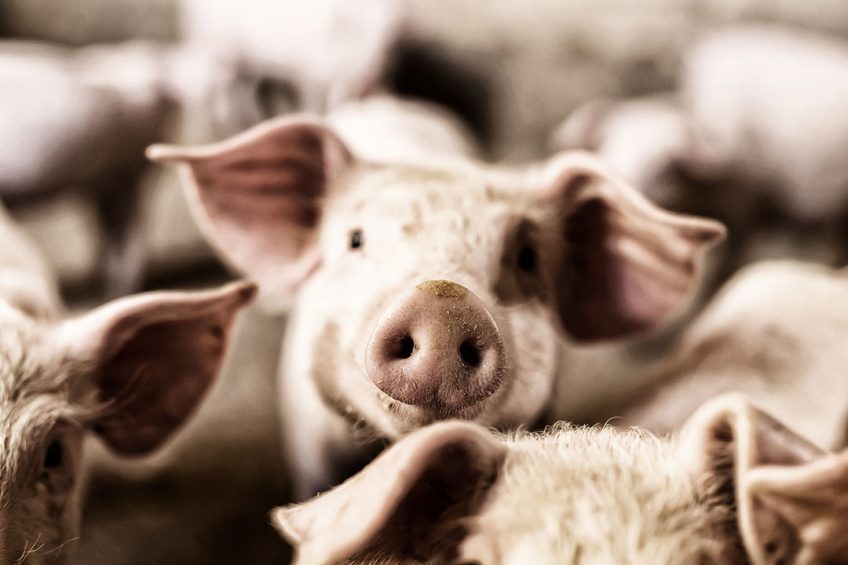Fatty acids promote gut health

Short- and medium-chain fatty acids are known for their antimicrobial activity and their extensive positive effects on gut health. But only a targeted combination of different fatty acids and other substances can exploit synergistic effects against Gram-positive bacteria.
Gram-positive bacteria represent the cause of many animal intestinal diseases. Infections with Streptococcus suis (S. suis) and Clostridium perfringens (C. perfringens) are considered to be a prime reason for the high use of antibiotics in pig production. The increasing antibiotic resistance has led to a ban on antibiotic use in feed additives in the EU. Therefore, there is increasing effort to move towards non-antibiotic alternatives. Piglets are generally infected already during or shortly after birth, with germs capable of entering the animal through even the tiniest wounds. Streptococci can than enter the bloodstream, where they settle in certain places in the body via the blood and reproduce. Once the pathogen has settled in the animal, it can cause a wide variety of disease patterns. Alongside pneumonia, inflammation of the joints and meningitis, Streptococci can also lead to sudden death. The aim is therefore to minimise the germ pressure as early and as far as possible.
Use and effect of fatty acids
Short- and medium-chain fatty acids and their derivates are particularly important in animal nutrition due to their specific nutritional and metabolic effects like fast digestion, energy supply and primarily because of their antimicrobial and antibacterial activity. Especially in piglet nutrition there is an increased application of fatty acids and specific combinations because of their impact on digestive processes and the intestinal microbiota. Lauric acid (C12) has the greatest antibacterial effect of all medium-chain fatty acids (MCFA). Primarily it is active against Gram-positive pathogenic and spoilage bacteria. Its spectrum can be enhanced when combined with other substances, for example different short- and medium-chain fatty acids. Furthermore, antimicrobial effects are reported for essential oils and their extracts. The group of phytogenic substances have been employed in pig diets for their digestion stimulating effects, antioxidant properties and in order to improve performance.
Due to these properties fatty acids and phytogenic additives are highly interesting for use in pig nutrition. The infection pressure, triggered by swine-specific pathogenic germs, is one of the main reasons for using antibiotic medications. Many in vitro studies displayed pronounced antibacterial effects following the use of fatty acids against both Gram-negative and Gram-positive germs. Lauric acid and glycerol monolaurate are considered to be particularly active antibacterial ingredients. The antimicrobial potential of MCFAs described in literature has already been applied in practice.
Reinforce immunity
Many different additives are already being used in pig feeding. Here it is important to reinforce the immunity of the animals and to reduce at the same time the use of antibiotics. The fields of application and the effect of the respective acids vary widely, however, synergistic effects can be created by targeted selection and with the combination of acids and other phytogenic substances.
The influence of different fatty acids on the development of swine-specific pathogenic germs was examined in an in vitro study. The objective of this study was to use the results to identify the most efficient combination of active ingredients that effectively inhibit bacterial growth. The antibacterial activity of the MCFAs caprylic acid (C8), capric acid (C10), C12 and myristic acid (C14), respectively the combination of different MCFAs, was examined towards various Gram-positive and Gram-negative bacteria. Additionally, the matrix encapsulated combination product, Bewi-Fatrix SynerG+, which is based on Lauric acid, monoglycerides of short-chain fatty acids and plant extracts, and of 2 further combination products (1 and 2) were investigated on the growth of E. coli, S. suis, Salmonella poona (S. poona) and C. perfringens.
The different bacterial strains were incubated in the presence of different concentrations of the mentioned active ingredients in a nutrient medium. Over a 15-hour period the bacterial growth was measured photometrically every hour through the absorption at a wavelength of 600nm. The results were evaluated via the data of the minimal inhibitory concentration 50 (MIC50).
Results of in vitro study
Lauric acid shows the greatest influence on bacterial growth. Particular for Gram-positive bacteria such as S. suis and C. perfringens the active ingredients in Bewi-Fatrix SynerG+ exhibit a distinct influence. Bacterial growth declines with increasing concentration of these active ingredients. In comparison with the 2 combination products 1 and 2, it became apparent that the addition of the product to the nutrient medium inhibits the growth of Gram-positive germs by 50% already at lower concentrations. Just 0.1% of the product is sufficient to reduce the bacterial growth of S. suis and C. perfringens by 50%. Furthermore, an influence of Bewital agri’s product on the growth of E. coli and S. poona can also be observed. Only 0.4%, respectively 0.6% of the product is sufficient in order to achieve MIC50 (Table 1). It was established that various concentrations of the antimicrobial active agents C12, C14, fatty acid mix C8/C10 and glycerol monolaurate influenced the in vitro growth of swine-specific pathogenic germs. Furthermore, the combination products 1 and 2 also displayed an antimicrobial effect with certain concentrations. However, neither combination product showed any uniform improvement by comparison with the individual active agents. Only the combination product Bewi-Fatrix SynerG+ showed a better effect here. It is evident from the in vitro analysis that the product innovation is the most effective available combination against Gram-positive bacteria. Initial feeding tests conducted on German, Spanish and Italian farms with confirmed S. suis infection showed that the use of the product as a feed additive led to a considerable reduction in the use of medication. The risk of infections is reduced, and performance of the animals is positively influenced. The farm managers reported more vital piglets and improved piglet growth.
Author:
Dr Ralph Schemmer, Bewital Agri









